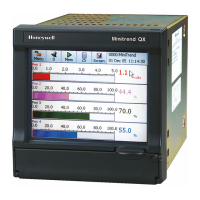43-TV-25-30 Iss.6 GLO Aug 07 UK 277
Table 14.5 :
Accessors Syntax Description
Ai Ai[x] Get the value of Analogue Input number x
Alamct Almct[x,y] Get the current alarm count for Pen x, Alarm y
(the alarm number as identified in alarm mes-
sages)
Alamrt Almrt[x,y] Get the current alarm number for Pen x, Alarm
y
Alamsl Almsl[x,y,z] Get the current alarm level set . Pen = x (1-96),
Alarm = y (1-6), New level to set = z.
Eg. P3 = almsl[1,1,A3] will set Pen 1 alarm1
and show A3 pen P3.
Alamst Almst[x,y] Get the current alarm state for Pen x, Alarm y
(I = active 0 = inactive)
Di Di[x] Get the state of Digital input number x
Glbv Glbv[x] Get the value of global variable number x
Locv Locv[x] Get the value of local variable number x
Pen Pen[x] Get the value of Pen number x
Tot TOT[x] Get the current value of totaliser x
Table 14.6 :
Boolean Operators Syntax Description
AND && Returns a true or false result from testing if two
tests are both true. e.g. IF (A1==GLBV1) &&
(A2!=GLBV2)
Assign = Assigns one variable to another.
e.g.GLBV1=A1. (GLBV1 becomes the value of
A1).
Equal to == Returns a true or false result from testing if two
variables are equal to each other. e.g. IF
(A1==GLBV1)
Greater than > Returns a true or false result from testing if one
variable is greater than another
Greater than or equal to >= Returns a true or false result from testing if one
variable is greater or equal to than another
Less than < Returns a true or false result from testing if one
variable is less than another
Less than and equal to <= Returns a true or false result from testing if one
variable is less than or equal to another
NOT ! Returns true if the result is 0, otherwise returns
false.

